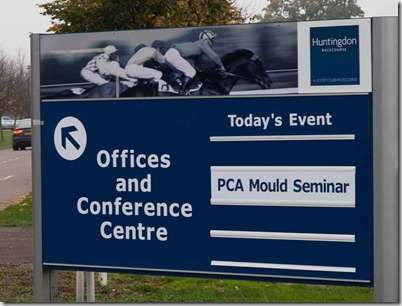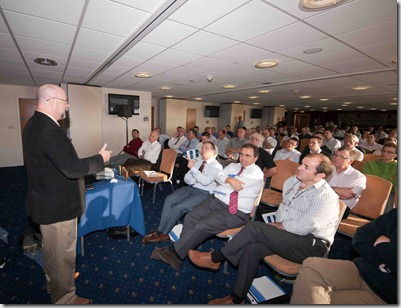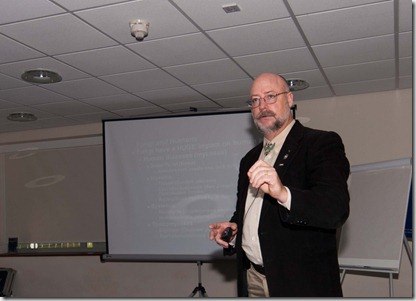November 15th 2011 and I was down at Huntingdon racecourse for the long awaited presentation by Caoimhin Connell. Caoimhin is an experienced and eminent occupational hygienist from the US and was a guest of the Property Care Association. He came over to talk to us about moulds because many of us openly admitted that we were lacking knowledge and needed education.
Why? Well there’s a growing band of people who believe that mould in houses is a serious threat to health and they are busy putting forward this view. Others (like myself), are sceptical. We decided we needed an independent expert’s help.
His presentation was broken onto five parts:
- Moulds and fungi – a basic introduction.
- Fundamentals of Toxicology
- Mould and Illness
- Sampling strategies and data interpretation
- Control strategies (Assessment).
Caoimhin didn’t mess around and it still took all day to get through the above, so I’m going to keep my review brief. This blog post is parts 1 & 2. I’ll post the others later.
Part one – Moulds and Fungi
This section was fascinating and Caoimhin filled in lots of blanks for me – moulds are just fungi, like dry rot, wet rot or mushrooms. However, they are in fact any filamentous fungi and don’t need to be small. They are ancient species and occupy virtually all environments from snow, to desert, to leaf litter and even our bodies (think thrush and athletes foot). All air samples contain mould – ALL.
Recognising mould species by eye is hard because they vary so much, even within the same species – with sexual and asexual states. Many moulds have more than one name, though only one genus. (later on Caoimhin explained that the species is irrelevant in most cases anyway).
Mould needs moisture to grow and food too. Food is everywhere so water is the factor which kicks off and sustains mould growth. The spores are produced and expelled for procreation and not all the time, so a growing patch of mould does not mean an automatically high spore count in the air (not that a high spore count matters anyway – see part 4).
We’ve lived with mould for millennia and there are still over 1000000 which haven’t been named yet. They are used in food, beer, marmite, wine, cheese, salami and drugs too.
Part Two – fundamentals of Toxicology
This was my favourite part because it put those terms we see in many newspaper reports in a new context.
Caoimhin went through the difference between toxicology and pharmacology. Hazard and poisons were covered – did you know that one of the toxic chemicals which mould experts say is going to kill you is found in ALL peanut butter too? Doesn’t matter though, the quantity is tiny and as Caoimhin told us “The Dose makes the poison’. And the dose is minuscule where mould is present.
A harmful substance can be present (like bleach under the sink), but the risk is tiny (it’s sealed in a bottle).
But the best bit for me though was the section on Epidemiology – the study of occurrence of end-points. He introduced three common concepts that are used (and abused).
- Association
- Correlation
- Causation
Mould is Associated with ill health! Sounds reasonable and is found in lots of mould experts adverts web sites and such. So what is an association? Sounds bad eh? In fact from the Epidemiologist’s point of view Association is almost less than nothing. It only means that an observation occurs with another observation – without further quantification.
For example (this is lifted straight out of the presentation).
- “…the last person who lived in this house died of lung cancer”
- “….the last five occupants of this house died”
- FACT – “Occupation of this house is associated with death”
- Fallacy – “This house is causing people to die”.
Facts:
- Virtually all people who have ever died lived in a house
- Absolutely all people who live in a house will die.
It follows then that associations are misunderstood by laypeople like me. If I see that the Daily Planet says mould is associated with illness and death I take notice. What a con! Using scientific speech out of scientific context causes this and is the stock in trade of those who would have us fear mould.
Correlation.
- This is a type of quantified association.
- Stronger than an Association
- Required for causation but independent of causation
- An event is observed to change with another event.
The correlation could be positive or negative.
In some studies the positive/negative bit is used to confuse readers. For example one study of Radon gas showed a correlation between lung cancer and radon levels. Sounds fair? yet when the data was checked the correlation was negative and less people died of lung cancer in the houses with the higher radon levels….counter intuitive and a surprise. This does not mean Radon is not bad for you –it just means that the report misinformed the reader in that case by not stating which way the correlation pointed.
Causation
- There must be a plausible biological response
- There must be a strong and consistent correlation
- The event, when removed, must result in an effect that fails to appear.
This is important because from an Epidemiologist view there is a confounder where mould is concerned – there is no causation resulting in illness associated with mould
I found this bit easy to understand and very refreshing.
Then it got a bit more complicated.
Caoimhin used shots of whisky poured into a tank of fish to demonstrate toxicity. This was fun and also very illuminating for a none –scientist (no fish were harmed, it was all done with slides).
So 15 shots were tipped in and 90% of the fish died
So the reference level (RfL) is 15 shots with a result of ED90
Some survived, so we see that not all members of a group respond to the same dose in an identical manner. Most died – these are the majority and death was the average effect of 15 shots. Of course, those who were sensitive died too, only the tough few (1), survived. These are the resistant individuals.
let’s try an RfL of 10 shots…
This time we get an ED50, so half the fish died.
Now try five shots RfL 5 = an ED10. The opposite of the results with RfL 15 – now only 10% died.
Ok, we don’t want anyone to die – what if these were our children and not fish. Three shots it is – RfL 3 – no deaths.
We now have a new term NOEL – No Observable Effect Level or. The Lowest Observable Effect Level (LOEL).
This means that at these concentrations we are at the lowest level at which there are statistically significant increases in frequency or severity of adverse effects.
So the lowest Observable Effect Level is used to:
- Establish a reference dose
- Establish a reference concentration
The reference dose is an estimate, with attributed uncertainty of daily exposure levels, including sensitive populations, that is likely to be without appreciable risk or deleterious effects during a lifetime.
The trouble is that these RfD and RfC’s are heavily weighted:
Uncertainty factors
reductions in the LOEL to account for known uncertainties.
Modifying factors
Reductions in the LOEL to account for unknown uncertainties.
This means that caution is used and a RfD of say 0.05mg/kg/day, may have been derived from a LOEL of say 1.0mg/kg/day – 20 times higher!
So it’s the uncertainty which drives science – as Caoimhin puts it – “Uncertainty is the heart and soul of science”.
I’ll skip the statistics and get to the quick –
What is a poison and how much is too much?
So what are these toxins in mould?
Lets go for the daddy of them all Trichothecenes. These are monstrously toxic and can be produced by the black mould Stachybotrys atra. They are officially classed as extremely toxic:
The LOEL is 0.03mg/kg/day
LD50 is 1mg/kg/day
LC50 is 200-5,800 mg*min/m3
So if you have Stachybotrys in your house you’re in danger, right?
In a very mouldy house covered with 500ft2 of the mould a study found 16,000 spores m/3. This was a flooded building – not cleaned, full of visible mould.
The Trichothecenes were measured very precisely:
the amount per m3 of air was 0.0000013 mg/m3 or 1.3ng/m3
Well the NOEL is actually 0.11mg/m3
So the amount in this mould city was about seventy six thousand times lower than the NOEL which is the No biological observable effect with inbuilt certainty and uncertainty.
From this the level of spores can be calculated thus:
Noel = 3000,000 spores /kg are needed.
The air concentrations needed to deliver that dose are to humans in 24 hours are:
Infant 2,100,000 spores/m3
Child 6,600,000 spores/m3
Adult 15,300,000spores/m3
The expected spore concentration in a house heavily infested with Stachybotrys is <200 spores/m3
Adult hazard quotient is 0.0000013 (virtually zero).
The story is the same for Aflatoxins, Fumitreorgens, Satratoxins and trichoverrols – even at 10,000 spores per m/3 (the very maximum you are likely to get in a very mouldy house), the amounts are below the LOEL by orders of magnitude.
Remember that the LOEL’s include susceptible persons.
Also, bear in mind that these complex chemicals are organic and are expensive for the mould to produce, so they are not manufactured for nothing. Moulds will produce these toxins is direct response to competition from other moulds. So most of the time they are not in ‘chemical warfare’ mode, they are in keep growing mode. Presence of mould doesn’t mean presence of toxins.
MVOC’s
And another thing – MVOC’s Microbial Volatile Organic Compounds.
These sound bad don’t they? The thing is though, that the long list of terrifying toxins above are all large complex molecules, so guess what? They are not volatile and do not form part of the MVOC’s. The smell of mould is due to MVOC’s which though unpleasant are not in any way associated with the toxins we are told to fear…..no mould fear monger will tell you that.
Remember – as I said above, toxins are there for a reason, why evolve a mechanism to makes these toxins and then waste them, by spitting them out into the air as volatiles? They are needed at the point of growth, where mould meets mould in a fight for territory, on the surface of the growing medium- not in the spores, which are basically seeds anyway; merely a packet of DNA waiting to settle somewhere moist.
What all this amounts to is that toxicity without quantification of risk is meaningless. The toxic mould crowd focus on toxicity and ignore the risk – which is vanishingly small.
see a short video of the day here PCA mould Seminar


